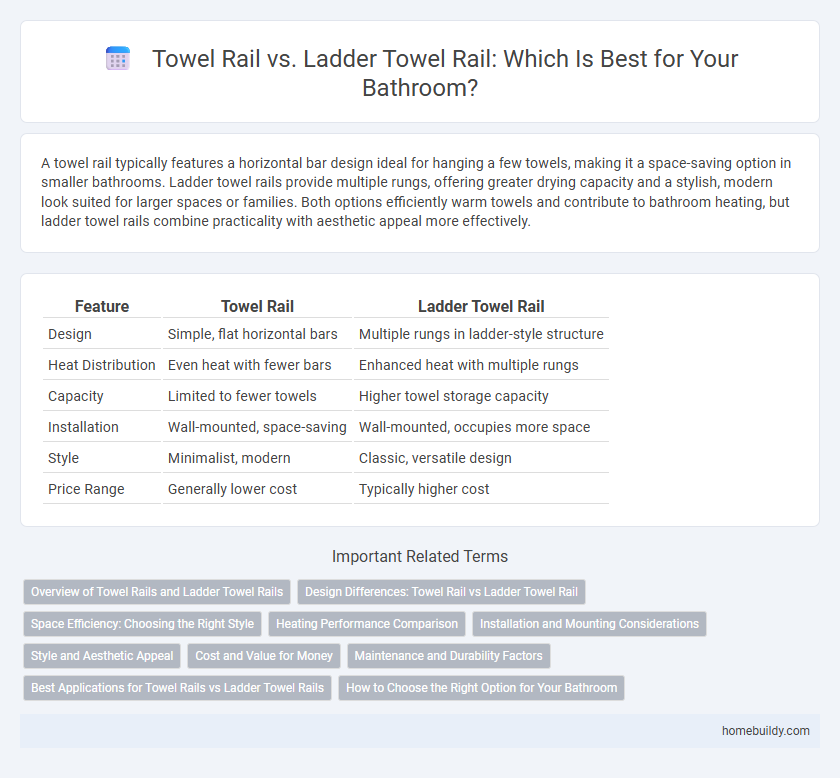A towel rail typically features a horizontal bar design ideal for hanging a few towels, making it a space-saving option in smaller bathrooms. Ladder towel rails provide multiple rungs, offering greater drying capacity and a stylish, modern look suited for larger spaces or families. Both options efficiently warm towels and contribute to bathroom heating, but ladder towel rails combine practicality with aesthetic appeal more effectively.
Table of Comparison
| Feature | Towel Rail | Ladder Towel Rail |
|---|---|---|
| Design | Simple, flat horizontal bars | Multiple rungs in ladder-style structure |
| Heat Distribution | Even heat with fewer bars | Enhanced heat with multiple rungs |
| Capacity | Limited to fewer towels | Higher towel storage capacity |
| Installation | Wall-mounted, space-saving | Wall-mounted, occupies more space |
| Style | Minimalist, modern | Classic, versatile design |
| Price Range | Generally lower cost | Typically higher cost |
Overview of Towel Rails and Ladder Towel Rails
Towel rails provide efficient drying and convenient storage with a sleek, horizontal bar design ideal for modern bathrooms. Ladder towel rails offer multiple rungs in a vertical frame, maximizing drying space while adding a stylish, contemporary look. Both types enhance bathroom functionality by combining practicality with aesthetic appeal, but ladder rails excel in accommodating multiple towels simultaneously.
Design Differences: Towel Rail vs Ladder Towel Rail
Towel rails typically feature a flat or tubular single-bar design that maximizes space efficiency and offers a sleek, minimalist aesthetic. Ladder towel rails consist of multiple horizontal bars connected by two vertical rails, providing greater drying capacity and a more structured visual appeal. The choice between the two depends on bathroom size, heating requirements, and stylistic preferences, with ladder rails often preferred for larger spaces and traditional designs.
Space Efficiency: Choosing the Right Style
Towel rails are ideal for maximizing space in compact bathrooms due to their sleek, horizontal design that fits flush against walls. Ladder towel rails offer increased drying capacity with multiple rungs but occupy more vertical space, making them suitable for larger bathrooms. Selecting between the two depends on balancing available wall space and the number of towels needing frequent drying.
Heating Performance Comparison
Towel rails typically provide consistent, evenly distributed heat due to their horizontal bars, enhancing drying efficiency and warmth in smaller bathrooms. Ladder towel rails, designed with vertical supports and multiple rungs, offer greater surface area for heat emission, resulting in faster drying times and improved overall heating performance in larger spaces. Choosing between these depends on room size and heat output requirements, with ladder rails often favored for superior heat dispersion.
Installation and Mounting Considerations
Towel rails typically offer straightforward wall-mounted installation, requiring fewer brackets and less structural support, making them ideal for standard drywall or tile surfaces. Ladder towel rails, featuring multiple rungs, demand more precise mounting points to ensure even weight distribution and stability, often needing reinforced wall anchors or studs for secure attachment. Proper alignment and spacing are crucial for ladder towel rails to maintain their aesthetic appeal and functional efficiency in drying towels.
Style and Aesthetic Appeal
Towel rails offer a sleek and minimalistic design, ideal for modern bathrooms seeking a streamlined look. Ladder towel rails provide a more structured and architectural aesthetic, often serving as a focal point with their multi-rung design. Both styles enhance bathroom decor by combining functionality with visual interest, but ladder towel rails tend to create a warmer, more traditional ambiance.
Cost and Value for Money
Towel rails generally offer a lower initial cost compared to ladder towel rails, making them a budget-friendly option for simple heating needs. Ladder towel rails provide greater surface area for drying towels and often incorporate more powerful heating elements, which can enhance long-term value despite a higher price point. Considering energy efficiency, ladder towel rails may reduce heating costs over time, delivering better value for money in well-utilized spaces.
Maintenance and Durability Factors
Towel rails typically require less maintenance due to their simpler design and fewer joints, reducing the risk of leaks or corrosion over time. Ladder towel rails, while offering enhanced drying capacity, may need more frequent cleaning and inspection to prevent rust in the multiple bars and joints. Durability favors towel rails with high-quality materials such as stainless steel or aluminum, but ladder towel rails often incorporate similar materials to withstand regular use and humidity.
Best Applications for Towel Rails vs Ladder Towel Rails
Towel rails are ideal for compact bathrooms or spaces requiring a sleek, minimalist design, providing efficient drying with limited wall space. Ladder towel rails suit larger bathrooms and utility rooms, offering multiple bars for hanging several towels or clothes simultaneously, enhancing air circulation and faster drying. Choosing between them depends on space availability, drying needs, and design preferences for optimal bathroom functionality.
How to Choose the Right Option for Your Bathroom
Selecting the right towel rail for your bathroom depends on space, style, and heating needs. Standard towel rails are ideal for smaller bathrooms with limited wall space, offering a compact and efficient drying solution. Ladder towel rails provide more hanging space and a modern design, making them suitable for larger bathrooms where both function and aesthetics are priorities.
Towel rail vs Ladder towel rail Infographic

 homebuildy.com
homebuildy.com